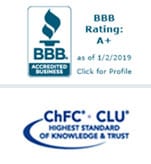

In 1969, the Beatles were still together, fringe was haute couture, and a Big Mac cost $0.50. Fifty years later, Abbey Road posters still adorn dorm room walls, but the only thing $0.50 will buy at your local McDonald’s is a sesame seed bun and a pitying look from the cashier. Like death and taxes, inflation is one of life’s certainties.
During your working years, when inflation can be offset by increased wages from raises and promotions, the fact that your dollar doesn’t stretch as far as it once did can be frustrating but it’s rarely cause for alarm. After retirement, however, rising prices can devour your fixed income. In the financial world, this is called inflation risk. Here’s how you can build an inflation-proof retirement plan.
1. Recalculate your retirement income
While the rate of inflation can vary widely from year to year, the historical average comes out to about 3%. That means your income will need to rise by about 3% each year just to keep pace with the cost of living. Here’s what that looks like over the course of a retirement.
All of our readers are unique and inspiring individuals, but let’s assume for simplicity’s sake that you are aggressively average; you retire the day you turn 65 and die the moment you turn 78.7 years old, which is the average U.S. life expectancy. You earn $47,000 a year, the median salary for Americans age 65 and up. If you want to have the same level of purchasing power at 78.7 that you had at age 65, your annual income will need to grow about 41% to $66,270. That 3% adds up quickly.
Now, imagine you live to 85, 95, or even 105—what will your retirement income need to be in order to maintain your current standard of living? Use this calculator to find out.
2. Invest in stocks
While the amount of risk you can tolerate in a portfolio falls as you get older, you should still maintain some exposure to stocks. Why? The stock market returns, on average, about 6% each year—more than enough to offset inflation under most circumstances. Stocks will also help to balance out bond holdings which are a more conservative investment but lose value as inflation increases.A financial advisor can help you learn what portfolio allocation makes the most sense for you.
3. Find insurance
Healthcare and long-term care are two of the largest expenses in retirement. And, thanks to inflation, the cost of these services can only go up. Rather than letting the price of healthcare eat into your retirement nest egg, try to pay for these services from another account or through an insurance policy.
4. Look into an HSA
An HSA or Health Savings Account is a type of tax-advantaged account that can be used to pay for healthcare, including out-of-pocket expenses, Medicare premiums, and long term care insurance. HSA accounts are attractive for three reasons: contributions are tax-deductible, growth is tax-deferred (i.e., growth is not taxed until the money is withdrawn), and withdrawals for qualified medical expenses are tax-free. Individuals can contribute up to $3,450 per year. Families can contribute up to $6,900. Be advised: after you enroll in Medicare, you can no longer make new contributions to your HSA.
According to the Department of Health and Human Services, almost 70% of Americans will require long term care at some point in their lives. Long term care insurance covers these costs so you won’t have to.
5. Make the Most of Social Security
Social security is a life-long income stream with built-in cost of living adjustments. While you should never be in a place where you’re dependent on this income, getting the most out of your Social Security benefits can help buffer you from rising inflation.
Popular ways to optimize your payout include delaying when you claim benefits, claiming benefits for a non-working spouse, and working for at least 35 years. Want to know which strategy is best for you? We offer free social security maximization reports that can help you lock-in the biggest benefit.
6. Consider an annuity
With a fixed index annuity, you receive a guaranteed stream of income for the duration of your life. These products are tied to an underlying index fund that helps grow your principal during both the accumulation and withdrawal periods.
While you’ll typically find less growth than if you invested directly in the stock market, fixed index annuities come with an added benefit: zero risk. The result? In years where the market does well, you have the opportunity to outearn inflation (this also depends on the specific product you choose). In years where the market drops, you won’t earn anything, but you won’t lose anything either, making these products a good choice for risk-averse investors.
It’s important to remember that the durability of your annuity is solely reliant on the insurance company that issues it, so you’ll want to do plenty of research before committing to a particular product. A trusted financial advisor can help you determine what type of annuity is best for your situation and steer you away from those issued by companies with poor reputations.


Sara McKinney
saractag@gmail.com
As Cowen Tax Advisory Group’s Digital Content Marketing Specialist, Sara provides in-house copywriting and manages the company’s electronic records system, email marketing, and blog.




